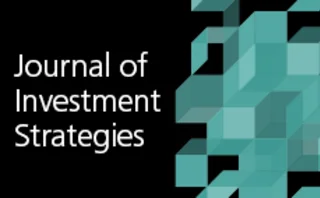Technical paper
The impact of de-tiering in the United Kingdom’s large-value payment system
The authors conduct a head-to-head comparison of central and bilateral clearing to evaluate the impact of market structure on market stability.
Interconnectedness risk and active portfolio management: the information-theoretic perspective
This paper extensively compares mutual-information-based networks with correlation-based networks on a stand-alone basis and in the framework of active investment strategies.
Pathwise XVA Greeks for early-exercise products
The calculation of XVA Greeks for portfolios with early-exercise products is discussed
Optimal investment and financing with macroeconomic risk and loan guarantees
This paper considers an entrepreneur who has no assets in place but possesses an option to invest in a project incurring a lump-sum investment cost, of which a fraction must be financed by entering into an equity-for-guarantee swap.
A latent variable credit risk model comprising nonlinear dependencies in a sector framework with a stochastically dependent loss given default
This paper proposes a latent variable credit risk model for large loan portfolios. It employs the concept of nested Archimedean copulas to account for both a sector-type dependence structure and a copula-dependent stochastic loss given default (LGD).
The profit-and-loss attribution test
In this paper, the authors analyze the failure probabilities of the profit-and-loss attribution (PLA) test as defined in the final market risk standard published in January 2016 by the Basel Committee on Banking Supervision.
Governance and organizational requirements for effective model risk management
This paper expands on the foundation of model risk analytics to address the governance, organizational and human behavior challenges associated with enterprise MRM.
Tail protection for long investors: trend convexity at work
In this paper, the authors show that single-asset trend strategies have built-in convexity, provided their returns are aggregated over the right time scale, ie, that of the trend filter.
Speed and dimensions of trading
In this paper, two new portfolio statistics are introduced: ENT, which measures trading speed, and ENTD, which measures trading diversity. Together with vectors representing major trading directions, these provide new insight into the intrinsic…
Gas storage valuation under Lévy processes using the fast Fourier transform
This paper presents the modeling benefits of using Lévy processes and the fast Fourier transform (FFT) in the valuation of gas storage assets and, from a practitioner’s perspective, in creating market-consistent valuations and hedging portfolios.
Identifying complex core–periphery structures in the interbank market
This paper proposes a framework to identify the structure of a financial network and its evolution over time, and presents an application to an interbank market with complete actual data.
Issuer bias in corporate ratings toward financially constrained firms
This paper considers whether the rating agency attempts to mitigate the feedback effect through its rating actions. Using Moody’s issuer ratings over 1982–2009, the paper shows that firms with greater external financing constraints are less likely to be…
Evolutionary algos for optimising MVA
Alexei Kondratyev and George Giorgidze apply two evolutionary algos to MVA optimisation
The FRTB’s P&L attribution-based eligibility test: an alternative proposal
Spinaci, Benigno, Fraquelli and Montoro propose two alternatives to the P&L attribution test
Optimal intraday power trading with a Gaussian additive process
This paper studies the problem of a financial agent wishing to maximize a constant relative risk-aversion expected utility of their terminal wealth while operating in an ID market.
A vine copula–GARCH approach to corporate exposure management
This paper applies vine copulas with GARCH marginals to the problem of capturing asset dependence and tail dynamics for currency and commodity exposures commonly found in portfolios of global corporates.
A model for the valuation of assets with liquidity risk
This paper describes a model for the valuation of assets on a bank balance sheet with liquidity risk. It applies the model to single cashflows, loans, bonds and derivatives. In addition, the calibration to London Interbank Offered Rate basis spreads is…
An enterprise perspective of performance attribution: introducing the keel model
In this paper, performance attribution is extended to an enterprise level based on the keel model. The keel model introduced here is applied to the problem of attributing enterprise value changes to various risk factors.
Determinants of foreign exchange risk: some further evidence
This paper employs the quantile regression model to examine Taiwanese companies and considers factors that researchers have identified which may influence orientation divergences for robustness testing.
New historical bootstrap value-at-risk model
This paper presents a new value-at-risk (VaR) model for the estimation of market risk in banks and other financial institutions.
Pricing multidimensional financial derivatives with stochastic volatilities using the dimensional-adaptive combination technique
In this paper, the authors present a new and general approach to price derivatives based on the Black–Scholes partial differential equation (BS-PDE) in a multidimensional setting.
Volatility risk structure for options depending on extrema
In this paper, the authors give a decomposition formula to calculate the vega index (sensitivity with respect to changes in volatility) for options with prices that depend on the extrema (maximum or minimum) and terminal value of the underlying stock…
Cumulative prospect theory and mean–variance analysis: a rigorous comparison
This paper proposes a numerical optimization approach that can be used to solve portfolio selection problems including several assets and involving objective functions from cumulative prospect theory (CPT).
A hybrid tree/finite-difference approach for Heston–Hull–White-type models
In this paper, the authors study a hybrid tree/finite-difference method, which allows us to obtain efficient and accurate European and American option prices in the Heston–Hull– White and Heston–Hull–White2d models.










